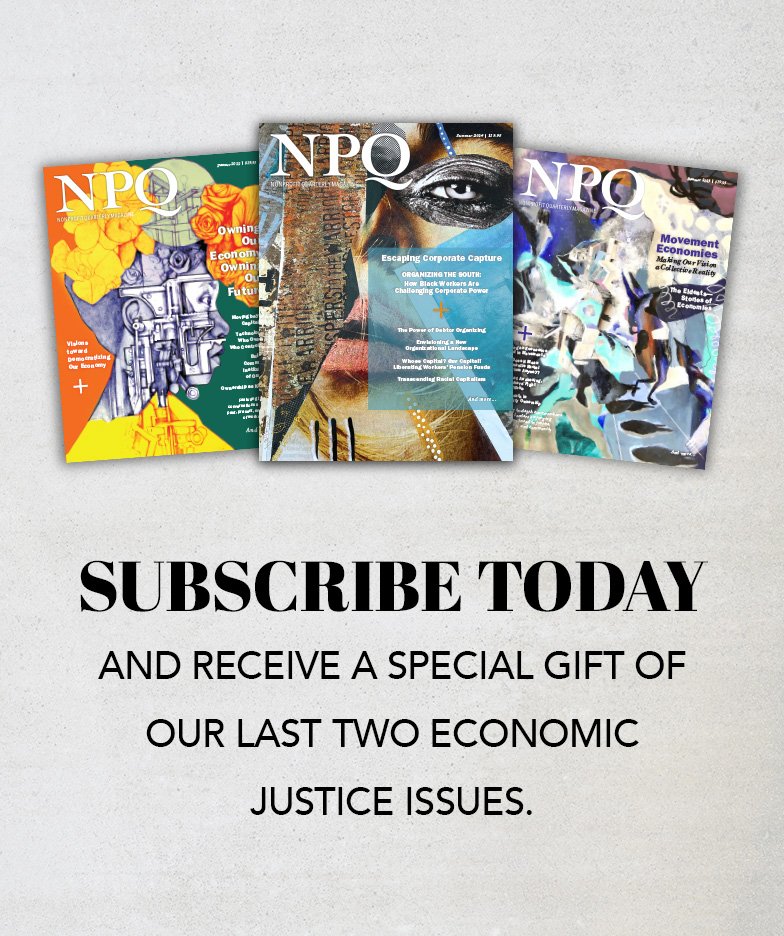The rules of the game of operating any enterprise are changing. Consider how the following have changed in the last few years:
- how we reach and serve customers and constituents,
- the pervasiveness of customer service ratings,
- the difficulty of finding and keeping talented and skilled people,
- the amount of procedural work done by technology,
- tougher requirements from funders for accountability,
- entry of for-profits into nonprofit and government space (for example, education),
- expansion of alliances across and within for-profit and nonprofit sectors, and
- the emerging free agent economy in which more people work under contract, as volunteers, for themselves, from home.
I could go on, but the point I want to make is that the world of work is just that—a new world. Accompanying all the changes in technology, customer and constituent behavior, and funding intricacies, is a profound pressure from clients, taxpayers, funders, and the workforce itself to change how institutions are run—how they operate, how they are managed. In a nutshell, the pressure is to democratize the workplace, unleash unlimited creativity in serving constituencies, and optimize value and performance for money.
Part of the problem is that the practices we need to implement today are foreign to most people. In fact, many work practices are only now being invented and tested—by us. Even the practices that are common sense and that we’ve talked about for so many years (such as involving people in decisions that affect them) are not automatic in practice. The old authoritarian, dependent, and elitist ways die hard, and are difficult to replace—especially if they become encrusted with the “new practice” rhetoric.
Many institutions recognize the need to change workplace practices and have put change programs and change management at or near the top of their agendas, but few have made breakthroughs. Many studies of the success rate of change programs find that 80 to 90 percent of change efforts fail to achieve their promised results. The U.S. Department of Labor has concluded that only about seven percent of U.S. organizations consistently use enough high performance management practices to be considered “new world of work” enterprises. In the private sector, huge gaps exist between the top customer-rated and average organizations. Investors in the private sector are willing to pay high premiums for well-managed businesses (between 17 and 27 percent, according to a McKinsey report1). However, investors have a hard time finding organizations that merit such premiums. There is no reason to believe that public and nonprofit institutions are any different.
So, how to move forward? How to create institutions in the nonprofit sector that can stand proudly and compete in this highly connected world? How do you shift to the new world of work that requires more democratic workplaces? The answers require all of us to commit to new ways of thinking about how institutions must run. And they require that today’s institutional leaders commit to making the tough changes that will create a new institutional legacy for future generations.
I don’t believe in imitation as a goal, but being aware of the research that tells us what works in organizations of all kinds can help drive success. Find it. Teach people about it.
For example, strong research indicates that:
- Customer and client satisfaction surveys don’t mean much. The true measure of customer satisfaction is either people coming back (a loyalty issue), or the “positive message to a friend” phenomenon. In the latter case, people are likely to tell two or three friends about a good customer experience, and 10 to 15 friends about a bad one.2
- While equitable pay is very important, things such as supervision and support methods, communication, hiring, and “having a best friend at work” are the key retention factors for people. This defuses the myth that you can “buy” talent that stays (an important realization for the nonprofit sector).3
- “Fast” companies—organizations that rapidly adapt and learn—balance people and technologies (they don’t sacrifice one for the other) while they create a sense of team.4
- The most productive organizations use high involvement people practices—where there is an open culture, clear goals, lots of learning, and shared success.5
- Organizations that encourage positive relationships among employees and clients are more creative than those that do not.6
- Changing human resource or people practices at the same time as restructuring makes it more likely that the intended changes will work and be sustained.7
- Leading organizations balance “loose” and “tight.” They are clear, focused and adamant about vision, goals and measurement (the “what”) and participative and flexible in implementation (the “how”).8
Use research findings to stimulate dialogue and ideas about innovation and change in your institution. Use them to provoke insight and creativity. For example, you may learn that an organization is using a unique community outreach program that raised its image in the market. You may decide to imitate its practices—sometimes this is a good idea. But don’t stop there. Use the thought to wake the organization up to new possibilities. Take it a step further and ask, “What other ideas does this trigger for us?”
We are at a stage in the evolution of institutions in which we need to find the things that are working, appreciate, adopt, and innovate on them. This is how nature works in evolution. It’s how we can and must evolve our human enterprises.
The work and service ethic in society today shows a legacy of bureaucracy, boss-subordinate relationships, and dependency. The emerging ethic is one of self-management, partnership, and power with accountability. Think of the changing client role in health care, welfare, and education. Think of the raised community responsibility for policing and crime control. Shared responsibility may be the theme of the new decade—or millennium!
But constituents and customers need education on their new roles. They also need to see that a partnership relationship is actually both more respectful and more effective. Likewise, people at work in the most productive organizations are taking more responsibility. They participate in more decisions, expect and get quality coaching support from people with administrative power, and are constantly developing. Such behaviors are new and sometimes scary for many people. There’s an inclination to say, “That’s my supervisor’s job.” Education about what great organizations are doing helps break up the old assumptions and create hope that something new is possible. It makes what seems foreign to many, familiar and desirable.
The people practices in an organization carry the DNA of the culture. If they are top-down, secretive, treated as a bureaucratic exercise, and inward-focused (what Steve Williamson calls the autocratic-bureaucratic method in the next article), they will create an organizational culture that has those qualities. Think of performance management. Are goals given to people? Does the supervisor alone “appraise” the individual? Is it primarily a paper—or computer—exercise? Is the training only for supervisors and managers, focusing on how to appraise others? If so, your organization is sending the old message. It’s also likely that people in the hierarchy select new employees, that promotions are relatively secretively handled, and that trust is relatively low. People probably spend more time worrying about the bureaucracy and satisfying or fighting the hierarchy than on meeting customer and constituent needs or creating a workplace that is “fun and challenging” (a characteristic of great enterprises).
The new work practices (what Steve Williamson calls collaborative-democratic methods) are customer-focused, participative, communication-focused, and strongly linked with mission and strategy. They are also geared to get the best from—and give the best (development) to—each individual. Performance management, for example, is a two-way communication. It draws heavily on feedback from the people an individual serves. The manager or supervisor role is to guide the process, help interpret, coach, and only occasionally take confrontational stands in the manner of the traditional boss. To do this, the manager must spend time at the front end making sure that roles are clear and renegotiated when necessary and recognizing and removing institutional barriers to performance.
New work practices also include selection processes in which the team is involved and either makes or advises the decision. (Other team members can make or break the success of a new hire.) They include promotion practices that are linked to deep understanding of the competencies required and the personal interests and energies of the person. Such understanding comes from open communication about the job requirements and a process that helps people understand themselves—their capabilities, interests, and energy levels.
Sign up for our free newsletters
Subscribe to NPQ's newsletters to have our top stories delivered directly to your inbox.
By signing up, you agree to our privacy policy and terms of use, and to receive messages from NPQ and our partners.
Finally, new work practices involve constituents and customers. Their feedback and ideas should shape the behavior of the institution, particularly in nonprofits.
Every enterprise is changing. Most have done specific things they might call “change management.” Many of these efforts seem to have failed. But, in the larger scheme, these efforts may have just been part of a longer process. Change happens in fits and starts. Projects that seemed to fail may really be part of the preparation for a breakthrough that occurs years later. The time lag and murky connections between action and impact shouldn’t prevent more change efforts. Having a history of failure or partial success actually makes it easier to achieve a breakthrough the next time.
Here are some ingredients and success factors:
• Get everybody involved. Ask people to help identify opportunity areas and problems, set up cross-group teams to solve them, and empower action.
• Educate people about why there is a need to change. Tell them about the changes that are happening in other places—and the impact of these changes on performance and work climate.
• Redesign the people practices early—they carry a big part of the culture message.
• Have a plan and time-lines, but as you learn about what works, know that you will make changes. Let the plan give you a feeling of control, but know that the change may cause other important ideas to surface. Many dramatic innovations have happened accidentally to people who were alert to opportunities (3M cultivates this alertness and thus accidentally discovered the opportunities of Post-It Notes).
Measurement is important as a self-management, learning, and education tool. And measures should be for the people who can act on them. In many cases, these actors are the people who do the work. Imagine driving a car without a speedometer. People at work need the equivalent of the speedometer, odometer, battery gauge, and more. And they can help identify what the measures are that can help them do great work. A place to start is with a question: What measurement information would help you anticipate problems faster, know how things are going, and support you in doing great work?
Measurement has gotten a “bad rap” through frequent punitive use. In many institutions measurement is just an instrument of control and reporting. So, people shy away from it or play games with the numbers. This is a culture issue (playing games indicates low trust), not an intrinsic problem with measurement. It’s time to release measures from their bureaucratic cell and support their role in creating great enterprise.
A key theme wherever we find high performance is that people feel connected to an important purpose. Public institutions and nonprofits are in a choice position here. Most are mission and values driven. But there needs to be a clear focus on and centrality of values and mission. There are two important areas to emphasize. First, raise the visibility of values by living them in customer and constituent interactions. This means moving from just words to behavior imperatives. It’s a great idea to meet from time to time to articulate the kinds of behaviors that reflect and don’t reflect the values with clients. This can turn into a self-assessment process, and a basis for feedback, appreciation, improvement and learning.
Secondly, take the values deeper into the organization. Research clearly shows that how employees and volunteers are treated affects how they work with clients. I remember when an airline was having labor-management problems. The employee at the ticket counter was surlier than usual—and not as fast. So, take some time clarifying how your institution’s values relate to relationships, actions and standards between individuals and groups. If there is a value of service, how does it translate into the workplace itself—to relationships between case workers or community outreach people and the internal staff that supports them? If there isn’t congruence, the real values are in jeopardy.
We live in interesting times. The pace of change has accelerated such that major change cycles are happening within our lifetimes instead of across lifetimes. This makes us more aware of change and makes change, innovation, consciousness, flexibility, and openness more prominent concerns and survival tools. I can remember times early in my consulting career when people said—and I agreed—“Let’s get this done so we can get back to business as usual.” The implication was that stability was the rule and change the exception. Well, the coin has turned. Fortunately, human beings, like all of nature, are programmed for change. The question is, will we change ourselves fast enough to become wise partners in using the information, communication, and workplace technologies that we have unleashed?
For leaders of nonprofits and public institutions, the call has special meaning. As heads of service institutions that touch people from all social sectors, your actions can rapidly become role models. Imagine the national and even global transformation that could occur if the leaders of all agencies adopted a two-pronged objective: to use partnership practices within the agency and for constituents and to role model a new kind of leadership and governance for society as a whole.
Interestingly, the most recent American Customer Satisfaction Index (ACSI) concludes that the only sector showing improved quality and customer satisfaction ratings today is the government sector.9 Ratings for private enterprise are dropping—and this is happening at a time when overall service quality seems either stuck or declining. The ACSI credits the government’s implementation of quality programs. But these can only go so far. Real and persistent change requires a sustained change of mindset and commitment from leaders. Those who choose to take up the challenge will make a difference for decades, perhaps centuries, to come.
- McKinsey & Company. 2000. Investor Opinion Survey. New York, NY: McKinsey. June. (www.mckinsey.com/features/investor_opinion/
- index.html)
- See “A Satisfied Customer Isn’t Enough,” by Thomas A. Stewart, Fortune, July 21, 1997, and the 2000 American Customer Satisfaction Index at (acsi.asq.org).
- Buckingham, M. and C. Coffman. 1999. First, Break All The Rules. New York, NY: Simon & Schuster.
- Birchard, Bill. 1997. “Hire Great People Fast.” Fast Company, August: 132.
- Kravetz, D. 1988. Human Resource Revolution. San Francisco, CA: Jossey-Bass.
- Stern, S. 1992. “The Relationship Between Human Resource Development and Corporate Creativity in Japan.” Human Resource Development Quarterly, 3(3): 215-234.
- Pil, F. and J.P. MacDuffie. 1996. “The Adoption of High-Involvement Work Practices.” Industrial Relations, 35(3): 423-455.
- Simon, H. 1996. Hidden Champions: Lessons from 500 of the World’s Best Unknown Companies. Boston, MA: Harvard Business School Press.
- American Customer Satisfaction Index, National Quality Research Center, University of Michigan Business School (acsi.asq.org).
Pat McLagan has consulted with institutions in the private and public sectors in America and overseas for 30 years. She lives both in the United States and South Africa, where she is professor of Human Resource Management at Rand Afrikaans University. Her most recent book, Change Is Everybody’s Business, will
be published in early 2001. Reach her at
[email protected]. (www.theritestuff.com)










